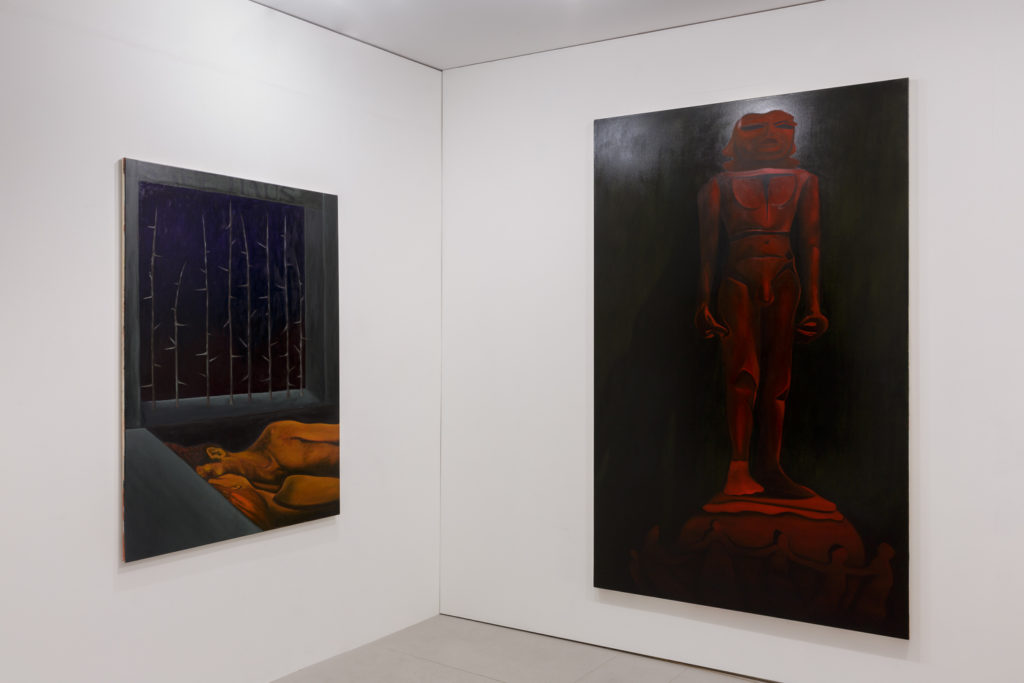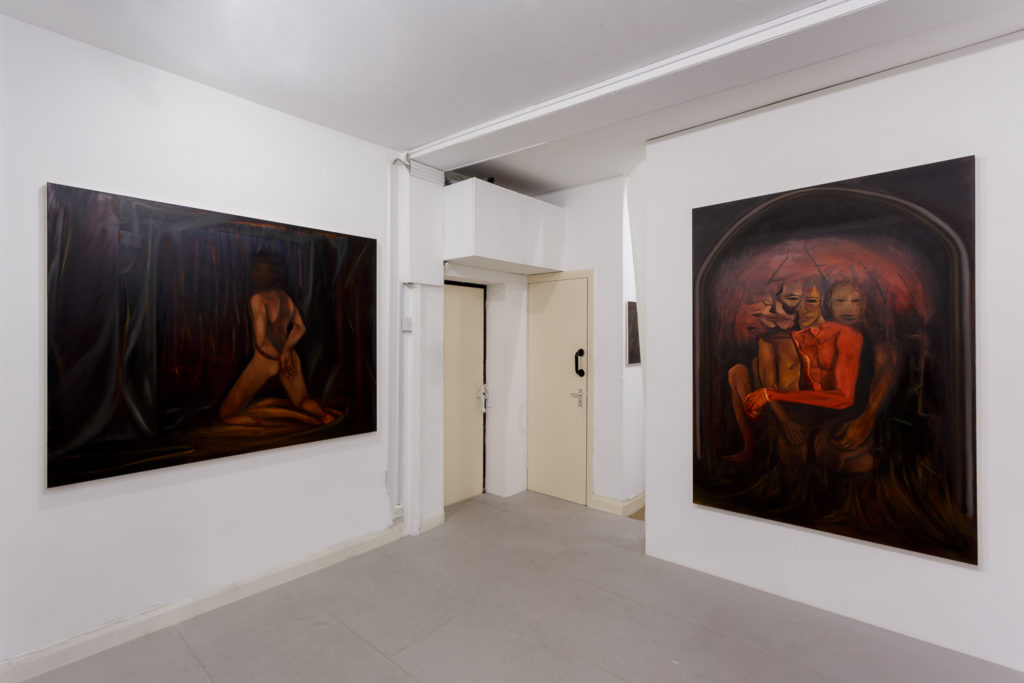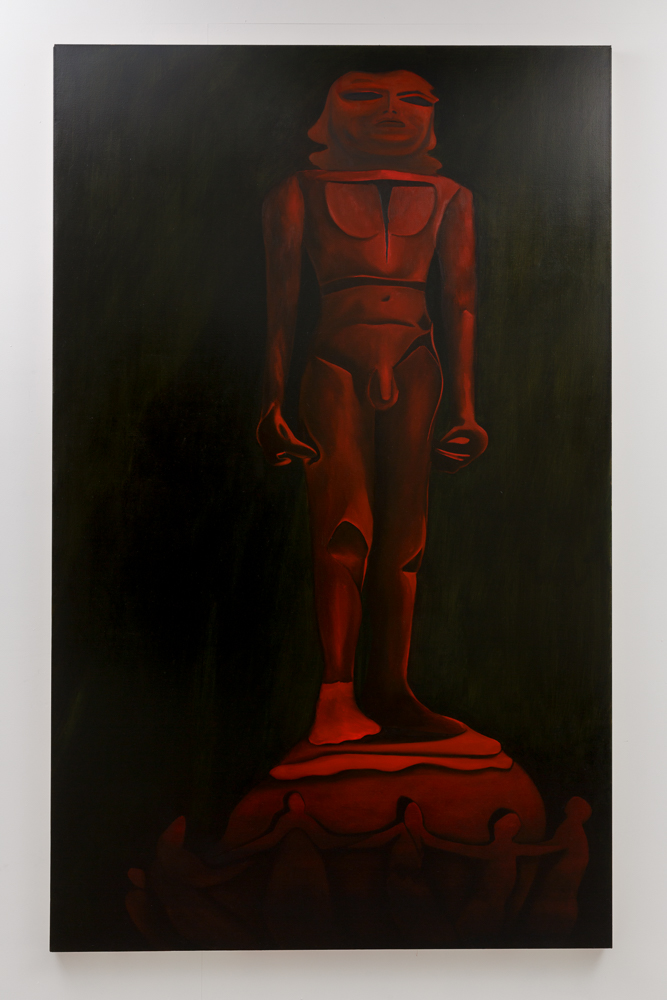











Instead of sounding himself as to his “being,” he does so
concerning his place: “Where am I?” instead of “Who am I?”
For the space that engrosses the deject, the excluded, is never
one, nor homogeneous, nor totalizable, but essentially divisible,
foldable, and catastrophic. – Julia Kristeva*
What becomes of the self in this space? – This is the question that the paintings of Lewis Hammond doggedly and arduously ask. They are visualisations of the many forces the body must undergo, the possibilities of what it could come between, or where it could – accidentally or not – end up. Incessantly interrogated and interrupted, the body is treated as a shock absorber, a mutable scapegoat for the antics of a poisoned and hostile world. It bears the violence of a homogenised and reductive space, one which wreaks havoc on the complexity of the bodies entangled within it; a space which is seemingly at odds with the outcome. The distribution of light and colour in his architecture is unequal and itself embroiled in the act of disorientation. Day, here, always happens at night. Rendered sunless and sombre, heavy with filtered light, washes and stains through which these scenes are sensed… We can but witness this world, try to see clearer how pervasive a passive gaze is upon it.
Much of Hammond’s work – exemplified by the paintings that make up The Keep – could be conceived of as self-portraits. They speak of his personal relationships, his black heritage, and most brutally the struggle to unearth suffering: to expose how far fear can infiltrate the very deepest and apparently safest core of the heart. The self is never completely alone in this centre, but rather alienated within a nightmare of Kafkaesque situations and procedures. They are disturbed and distracted in their process of self-identification, the same process which renders indistinguishable fact from fiction, hegemony from actuality, a shelter from a cage, but yet still manages to split the where of a body from the who of a soul.
The places elicited in another question posed by Hammond – What is happening here? – are many, and constantly escape localisation. Like De Chirico’s portraits of people whose bones and organs are comprised of anachronistic architectural features, the self is often found in a disoriented state, a composite of histories located using scrambled coordinates. It is not clear whether the self in the confines of Putting Myself Back Together II (2019) is mutilated, or multiplied: if the repeated versions of faces and bodies have been torn apart by their situatedness, or have extended themselves outwards in an attempt to escape it. It is not clear whether the lovers in Safe Haus (2019) will sleep for a night or for an eternity: temporarily distorted by some glitched perspective, or sunken into the ground to rot, both suffocated and frozen by the very security of the walls that embrace them.
Hammond’s forsaken subjects frequently appear to have been forced to take on animal form. Instead of echoing an Afrofuturist assemblage, where this mythology is asserted as a vital part in black self-determination, the challenge to the opposition between human and animal beings in Hammond’s work nearly always acts as a hindrance. It is as if a white colonial gaze has yet again intercepted a reclamation from its Enlightenment distinctions. In Never Again / Pony Club (2019), the self has lost their hands and feet to a set of hooves, made to stand on all fours. Their animal features are clearly an imposition, an additional zoomorphic blindfold, a straightjacket of unlearned limbs. All attempts to maintain the visualisation of empowerment are rendered null and void in a mirage of ruptured surfaces, quilts of skin held by neglected dioramas. In all of these representations, it matters which creatures – real or fictional – make up the body, as it matters where and by whom the images of this body are produced. In one ongoing series of small portraits, black men and boys are characterised as devils, bearing horns of the Beast or other distorted features. A title of one painting from this series, Fear of the Other (2018), leaves no doubt as to who controls the production of this identity.
Like an indefatigable shadow of this othering, the language of funerary ritual and a constant insistence on the awareness of mortality saturates Hammond’s paintings. Ancient Egyptian sarcophagi are awakened by the bodies that they have buried, perhaps a comment on the act of representation itself: subjects are not captured by his paintings, they are entombed in them. Hawthorn branches have become an enduring motif of the deathly, a weed that instead of fracturing buildings’ foundations acts to reinforce them, their rigid thorns further aiding the impenetrability of their walls. Here, the selves that Hammond depicts grapple not just with the prospect of their death, their aloneness in becoming a thing, but with their very living, the very life of a thing that has a soul.** They surely must be dead, and yet they still continue to breathe. In The Keep, this contradiction is laid bare. We find them in the place they are most under threat, the safest place of all.
Josephine Baker
*From “Approaching Abjection” in Powers of Horror, p. 8.
** “[The human being] is alive; he has a soul; and yet – he is a thing. An extraordinary entity this – a thing that has a soul. And as for the soul, what an extraordinary house it finds itself in! Who can say what it costs it, moment by moment, to accommodate itself to this residence […] there is not a single element of its nature to which violence is not done.” Simone Weil, The Iliad or The Poem of Force from An Anthology, p. 185.
Works
Gallery (from left to right):
Putting Myself Back Together II, 2019
Oil on canvas
180 × 130 cm (70 ⅞ × 51 ⅛ inches)
That time, when things were okay, 2019
Oil on linen
40 × 30 cm (15 ¾ × 11 ¾ inches)
Safe Haus, 2019
Oil on canvas
140 × 100 cm (55 ⅛ × 39 ⅜ inches)
Every Second, Every Minute, Every Hour, Every Day, Every Week, Every Month, Every Year, 2019
Oil on canvas
210 × 130 cm (82 ⅝ × 51 ⅛ inches)
Study For A Threshold / Longing and Impermanence, 2019
Oil on canvas
130 × 170 cm (51 ⅛ × 66 ⅞ inches)
Office (from left to right)
Untitled (Excoriation), 2018
Oil on linen
35 × 30 cm (13 ¾ × 11 ¾ inches)
Stop, Search, Destroy., 2019
Oil on linen
40 × 30 cm (15 ¾ × 11 ¾ inches)
Two Figures In A Landscape, 2019
Oil on canvas
150 × 130 cm (59 × 51 ⅛ inches)
Never Again / Pony Club, 2019
Oil on canvas
200 × 150 cm (78 ¾ × 59 inches)
Der Rücken (The Back), 2019
Oil on canvas
51 × 40.5 cm (20 ⅛ × 16 inches)